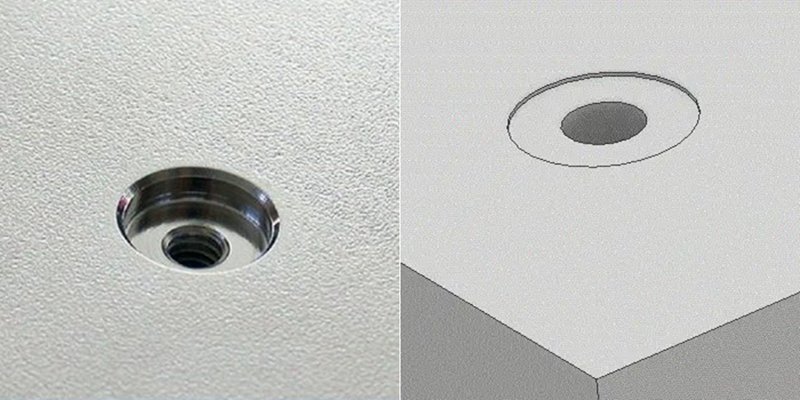- March 17, 2024
Counterbore and spotface are two of the most common hole-making applications in machining. While their core purpose is the same: accommodating fastener heads, some of their subtle differences professionals often cause professionals to confuse them with each other.
This article aims to provide a comprehensive comparison of counterbore vs spotface holes. Read on!
What is a Counterbore Hole?
Let us begin with the simple question of what is a counterbore hole. A counterbored hole is a flat, cylindrical recess machined coaxially around an existing screw/fastener hole.
The purpose of a counterbore is to accommodate the fastener’s head in a convenient, non-intrusive way. A counterbore hole is deep enough for the fastener head to sit flush with or below the workpiece surface.
This is a design requirement in most parts, where fastener heads protruding above the surface are undesirable due to issues like assembly constraints or part aesthetics.
For example, look at the picture below. The screw is necessary to assemble the electrical socket parts. However, the screw head can hinder plugs from fully plugging into the socket. Thus, a counterbore hole is added to solve this problem.
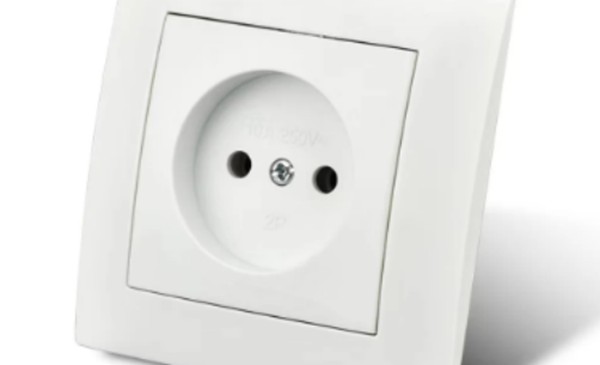
Counterbores in Engineering Drawings
Holemaking is a very diverse machining operation with several kinds of hole geometries. Owing to the variety of holes in engineering design, a counterbored hole is generally indicated on a drawing using a counterbore callout.
An example of this is shown in the figure below. The technical drawing shows a 13.5-diameter drill hole with a counterbore. This drill hole will serve as the pilot hole for the counterbore operation.
The counterbore callout indicates the size of the counterbore as 23.79 and its depth as 7.5.
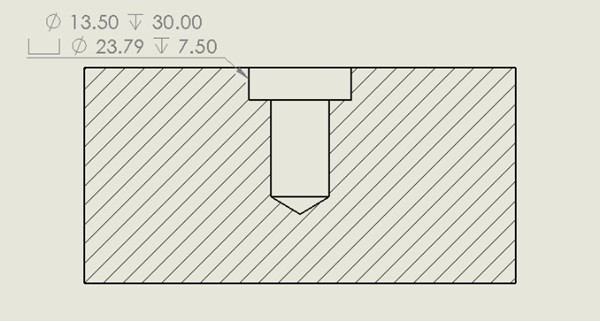
What is a Spotface Hole?
The next question in this discussion on spotface vs counterbore is to understand what is a spotface. The easiest way to define it is a shallow counterbore. This means that, just like a counterbore, it is a flat, cylindrical recess over a pilot hole. However, the depth of a spotface hole is much smaller than a conventional counterbore.
Functions of Spotface Holes
The main function of a spotface is to provide fasteners with a flat, level seat to sit against. If a fastener seat is uneven and rough, it can create unwanted stresses in the fastener’s body, which can damage it. Therefore, a spotface is useful in ensuring a smooth mounting surface for the fastener head.
Another important application of a spotface hole is to make fastener installation at an angle convenient. Some assemblies require fasteners to be at an angle to a flat surface, in which case a flat seat is necessary for fastener assembly. This flat seat is thus achieved with a spotface, as the figure below shows.
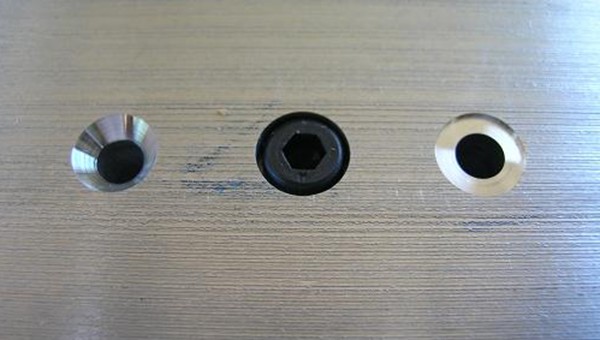
It is to be noted here that spotface should not be confused with countersinks. Countersinks are very similar to spotface holes but do not have a flat bottom, but rather an angled one to accommodate cone-shaped screw heads.
Spotface Holes in Engineering Drawings
As with counterbores, spotface holes also have a unique symbol for engineering drawings. The spotface symbol is derived from the counterbore callout, with an ‘SF’ marking included inside the regular counterbore symbol. SF in this case is for Spot Face.
The image below shows a simple example of a spotface callout. The spotface feature is 50 in diameter and has a depth of 1.
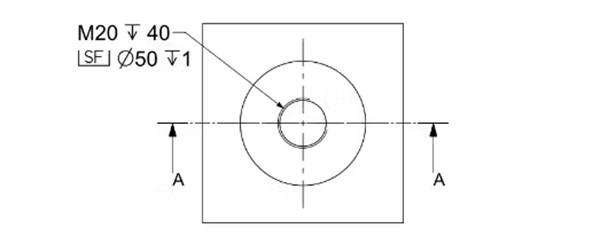
Counterbore vs Spotface: A Detailed Comparison
Now that the concept of both counterbore and spotface holes is clear, it is time to take a deep dive into the counterbore vs spotface comparison. While they are quite similar, as we just saw, their uniqueness is easy to understand when you explore their differences.
The discussion below presents the major differences between spotface vs counterbore.
Function
The main difference between counterbores and spotfaces is that of the design application. Before going into the differences, though, let us clear the air by mentioning the commonality. Both counterbores and spotfaces are meant to accommodate fasteners by providing a flat seat and recess for the fastener head.
Counterbores, however, have the additional function of completely encompassing the fastener head beneath the workpiece surface. This is done to avoid the fastener head protruding above the surface and creating assembly restrictions.
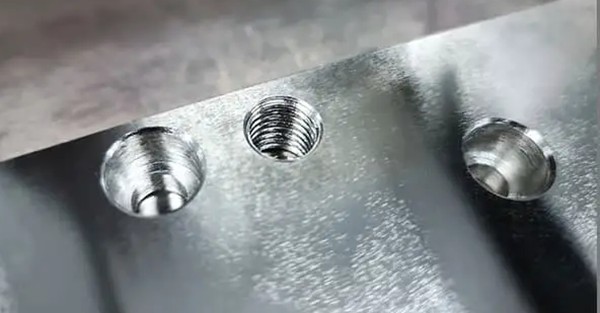
Depth
Counterbores and spotfaces differ in terms of hole depth. As is clear from its functionality explained in the section above, counterbores are at least as deep as the height of the fastener head. This way, after assembly, the fastener head hides completely beneath the surface.
Spotface depth is much smaller. It is kept just enough to provide a flat, recess seat for the fastener head.
Engineering Drawing Symbol
Another major difference between spotface and counterbore is the engineering drawing callout. As discussed above, the counterbore callout includes the ‘⌴’ symbol, representing the cross-section of a counterbore. It includes the diameter and depth of the counterbore.
The spotface symbol is derivative of the counterbore symbol, with an ‘SF’ placed inside it. This conveys the designer’s intent to the machine operator, along with exact specifications like diameter, depth, and surface finish.
Surface Finish
The surface finish is generally different in the counterbore vs spotface comparison. While both holes are kept very smooth to provide a flat, even mounting surface for fasteners, spotfaces usually have a finer surface finish.
This is mainly because the sole purpose of a spotface is to provide a level mounting surface to achieve the appropriate clamping pressure, while counterbores can have rough side walls without affecting functionality.
A Brief Table
| Counterbore | Spotface | |
| Functions | Provide a cylindrical recess to fastener heads to sit flush against a surface. | Provide a smooth seat for fastener heads to sit against. |
| Depth | At least as deep as the fastener head’s height to completely conceal it. | Very shallow depths, typically less than 5 mm. |
| Size | Diameter and depth are both equally important in defining counterbore size. | The main dimension of a spotface hole is the diameter, with the depth being a secondary dimension with loose tolerance. |
| Symbol | ⌴ | SF |
Counterbore and Spotface Machining
Counterbore and spotface machining is generally not highly challenging but the machinist must be clear about the main procedure. Both counterbores and spotface holes require a pilot hole to begin with. Machinists make this pilot hole using typical hole-making techniques like drilling, boring, or milling.
The second step is to use special counterbore/spotface tools of the correct size to make the desired hole.
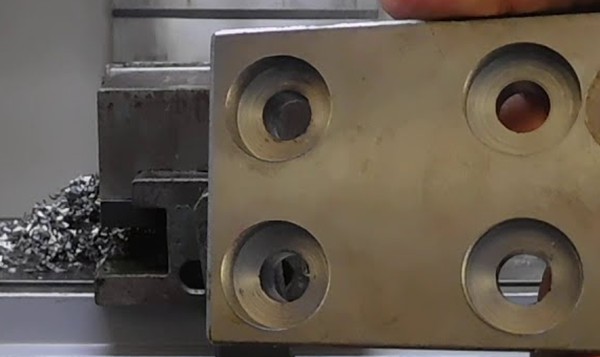
For this, the most important objective is to ensure that the tool is perfectly coaxial with the pilot hole. Otherwise, the tolerance on the hole dimension is violated and the fastener may not even sit well into the counterbore/spotface.
Lastly, the machining operation opens up the pilot hole to create the required feature. Since counterbores and spotface holes are usually secondary geometric features, experts prefer to decide between manual machining and CNC machining based on the primary part geometry.
Whatever that choice is, it also applies to auxiliary hole-making procedures like counterbore/spotface machining.
Counterbore and Spotface Tools
An important distinction in the spotface vs counterbore discussion is the difference in machining tools for each feature. Although there is no single tool for each as both have similar geometries, machinists do sometimes use specialized tools.
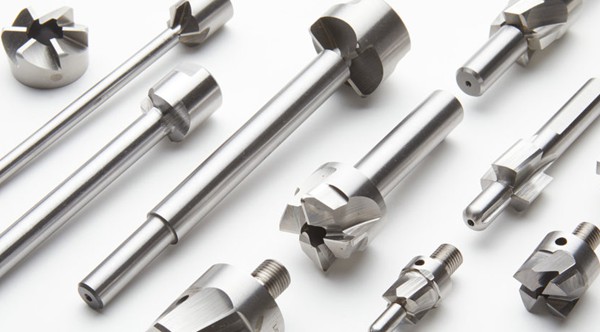
The image below shows these different geometries. A counterbore tool is like a milling tool or a ream because it needs to achieve a larger depth. On the other hand, a spotface tool typically has very short cutting teeth.
Moreover, some of these tools also have a central anchor to guide the tool inside the pilot hole. This helps in maintaining coaxial and straight tool descent along the toolpath.
Conclusion
The features of counterbore vs spotface play a crucial role in manufacturing complex assemblies and have a specific purpose in guaranteeing the success of a design. As engineers or manufacturers, it is good to know about their differences, engineering drawing symbols, and machining techniques and tools.
WayKen Rapid Manufacturing is a custom manufacturing company that specializes in CNC machining services. Our dedicated team is highly experienced in providing manufacturing solutions for custom machined parts including counterbore and spotface parts.
Contact us with your projects and get an instant quote!
FAQs
Are counterbore and spotface machined with different tools?
There are specialized tools for both operations. However, in some cases, they may also be machined with similar tools like endmills, or finished with a reamer.
What is the main difference between counterbore and spotface?
A counterbore is usually deeper into the surface than a spotface. Moreover, the main purpose of a counterbore is to provide a level seat for the fastener and encompass the fastener head, while a spotface is only machined to provide a balanced, level seat to the fastener.
How are spotfaces and counterbores dimensioned?
Counterbores are dimensioned based on the size of the fastener head. The diameter should be large enough to accommodate the fastener head and the counterbore needs to be at least as deep as the height of the fastener head to fully engulf it inside the workpiece surface.
For spotfaces, the diameter dimensioning is the same as counterbores, but the decision of the hole depth is up to the designer. Usually, it is kept very small at under 0.5 mm.

